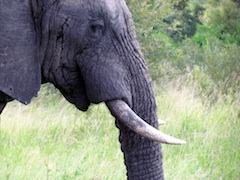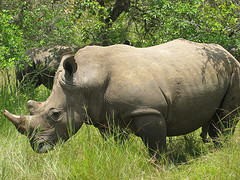Religions belong at the forefront of environment and wildlife protection
February 7, 2013:
 |
 |
 |
Tens of thousands of wild elephants are killed each year for their tusks. Photo: David Berkowitz |
The crucial role played by faith leaders in protecting wildlife and the environment is recognised in a major interview with one of ARC's partners in the influential New Scientist magazine.
Dekila Chungyalpa, director of WWF US's new Sacred Earth programme, was interviewed by the New Scientist for an article in its February edition headlined 'Visions of heaven on Earth: Sacred sites in danger'.
She pointed out that more than 80 per cent of people in the world identify themselves as religious and, collectively, faith-related institutions make up one of the largest categories of financial investors and operate over half of all schools globally.
"It is clear that religious leaders can have a strong influence. In sheer numbers, they are a major stakeholder for conservation," she said.
There are two levels on which faith leaders could help environmental efforts, she added: "The first is by leading their communities to make ethical choices, such as becoming energy efficient or eschewing illegal wildlife products.
"The second is more nuanced - and that is to challenge the idea that a sustainable future is not attainable."
Sacred Earth
 |
| "The profits made from the killing of African rhinos and elephants and Asian tigers are about $10 billion each year. This is not local poaching, it is wildlife crime. It is a trade run by international crime syndicates" - Dekila Chungyalpa, director of WWF US's Sacred Earth programme |
|
 |
 |
WWF's Sacred Earth programme was launched last year. Dekila said that mapping great areas of remaining biodiversity around the world had revealed that many are also sacred sites.
"In several of these areas, we know that religious belief has been one of the major factors for preserving them," she said.
"For example, Sagamatha National Park in Nepal is sacred to the Sherpa people, and the Kaya Forest in Kenya is sacred to the Mijikenda. In both cases, this status has led to their preservation. But sadly many sacred sites are threatened by illegal wildlife trade, deforestation, climate change, natural resource mining, pollution, and so on."
Rare and endangered speciesDekila also highlighted the programme which ARC and WWF launched in Kenya last year to engage faith groups in Africa and Asia in protecting rare and endangered species.
 |
 |
 |
Record numbers of rhinos were killed in South Africa in 2012: Photo: Jocelyn Saurini |
She told New Scientist: "In September, the UK-based Alliance of Religions and Conservation held a conference in Nairobi, Kenya. It was to celebrate Christian, Hindu and Islamic faith groups in Africa that are launching long-term plans for conservation.
"As part of the conference, we hosted a safari to Nairobi National Park. There we prayed around a pile of charred elephant ivory at a memorial site where hundreds of tusks were burned in 1989 to draw attention to the illegal killing of elephants.
"With ARC we also launched the first ever partnership with faith leaders across Africa against wildlife trafficking and the slaughter of elephants and rhinos. Fifty religious leaders signed pledges committing to the cause. I just learned that one preacher is writing a liturgy specifically on the protection of wildlife.
"We are working with Buddhist leaders in Thailand and other parts of Asia, encouraging them to preach compassion for African elephants and other species and call for an end to the use of illegal wildlife products. We are also developing a campaign that educates the public to reduce the demand for blood ivory driven by local cultural norms."
You can read the full article on the New Scientist website but you will need to subscribe; alternatively you can read it in New Scientist's February edition.
WWF US Video with Dekila Chungyalpa introducing the Sacred Earth programme
|

